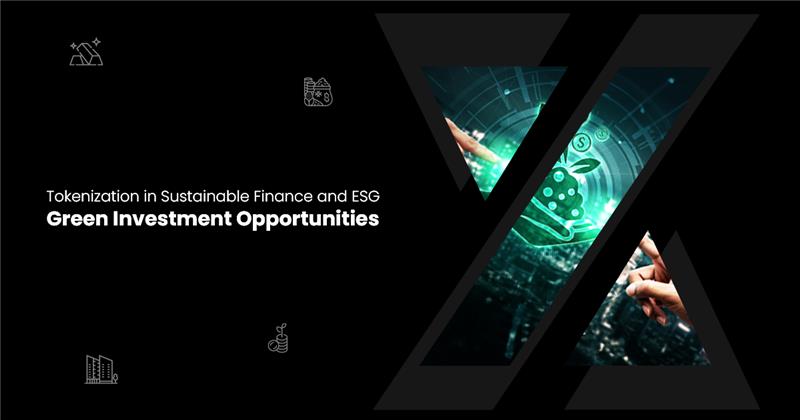As the world is moving swiftly towards technological advancements, a larger part is in line with addressing the needs of sustainability. There are several steps taken to fulfill the dual requirements of the masses, one being financial growth and the other being the sustainable approach and practices towards these developments. One of these approaches is tokenization in sustainable finance.
A recent exemplary case can be seen with the pilot project of platforms like CarbonX and Verra enabling the tokenization of carbon credits, and further encouraging buying, selling, trading, and investing in the same. This trend is positioned for wider adoption in 2025 as institutions, corporations, governments, and even individuals are in line with pursuing sustainability-driven carbon targets. In today’s blog post, we’re going to discuss the future prospects of ESG criteria for tokenized assets, categories of tokenized sustainable initiatives, advantages of blockchain for ESG investment in tokenized assets, and their impact on both investors and environment.
Key Takeaways:
- Tokenization is transforming sustainable finance by inducing security, transparency, liquidity, and accessibility in these assets.
- ESG (Environmental, Social, Governance) investments are gaining momentum and now are being integrated with tokenization, supporting green bonds and renewable energy projects.
- Tokenized assets in sustainable initiatives make green investments more accessible to a global pool of investors.
- The increased accessibility, global connectivity, and reduced entry barriers to these assets democratize the green market.
- Blockchain ensures transparency, traceability, and immutability in these assets, hence securing investments in eco-friendly projects.
Exploring the ESG Potential of Tokenized Assets
ESG initiatives stand for environmental, social, and governance initiatives that support approaches that are environmentally friendly, socially responsible, and as per right governance. When it comes to asset tokenization ESG initiates ensure that trading and investments in these assets conform with environmental, social, and governance criteria.
Environmental: Tokenization by allowing trade and investments int he green bonds, renewable energy, carbon credits, and water rights supporting green investment opportunities.
Social: Tokenization allows investors of all kinds to participate in the tokenized assets by lowering the entry barriers and allowing fractional ownership. This increases the investor’s participation and democratizes sustainable investment opportunities.
Governance: Tokenization powered by blockchain technology allows decentralized ecosystem for the assets to be traded and invested in. It enhances transparency and security, reducing fraud risks and building trust among stakeholders in ESG investments.
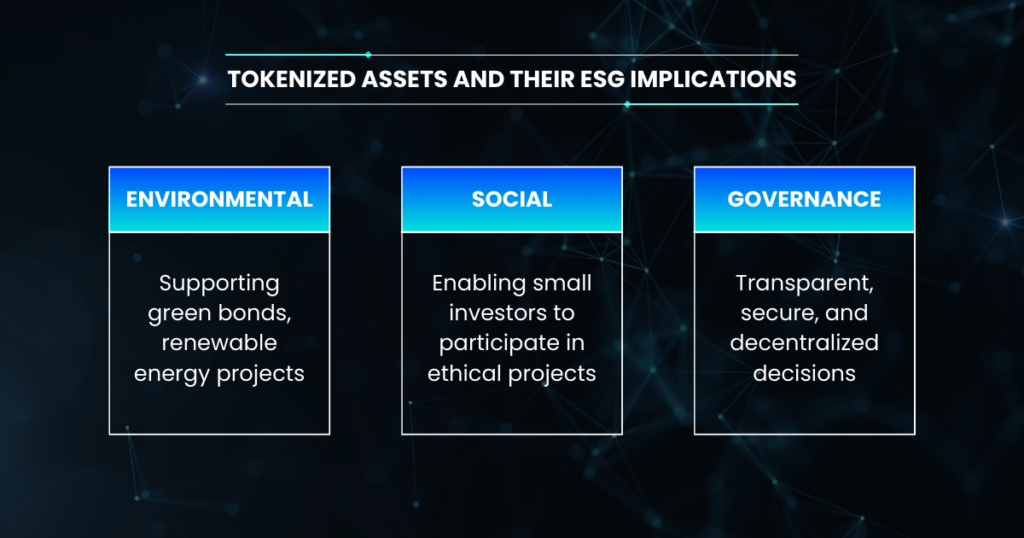
Dimensions of Tokenized Sustainability Initiatives
The integration of tokenization in real-world assets including sustainable projects and initiatives has opened a new domain. These are the areas where finance meets sustainability, and a more environment-friendly and socially responsive approach starts. The domain opens up in multiple dimensions which one way or another changes the facade of both finances and sustainable practices. Here are a few tokenized sustainable initiatives:
Renewable Energy Projects
One of the innovative approaches to environmental tokenization is renewable energy which enables investors to trade and invest in their tokens. These tokens represent their shares in projects such as solar farms and wind turbines, bringing liquidity to these green investment opportunities. Further, this step allows small and retail investors to engage in financing sustainable energy generation and at the same time tracking energy production by leveraging blockchain technology.
Carbon Credits
Sustainable finance tokenization is not limited to green project initiatives but is also prevalent in the domain of carbon credits. Tokenization in carbon credits allows trading and investments in emissions. Moreover, blockchain technology empowers investors and institutions with transparency and traceability, allowing them to offset their carbon footprints. This approach encourages accountability in achieving sustainability goals.
Plastic Waste Recycling
Green asset tokenization is not the only way to towards sustainable and ESG investments. Another important segment is the rise of tokenization in plastic waste recycling. This method incentivizes not just institutions but also individuals to contribute to the recycling practices and henceforth reward them with digital tokens.
Biodiversity Conservation
Tokenization in biodiversity conservation initiatives enables investors and even organizations to support funds by investing in digital tokens. These tokens represent commitment and zeal to preserve natural habitats, endangered flora, and fauna. Further, through blockchain technology, tokenization can create a transparent funding framework supporting the ecological cause and sustainability.
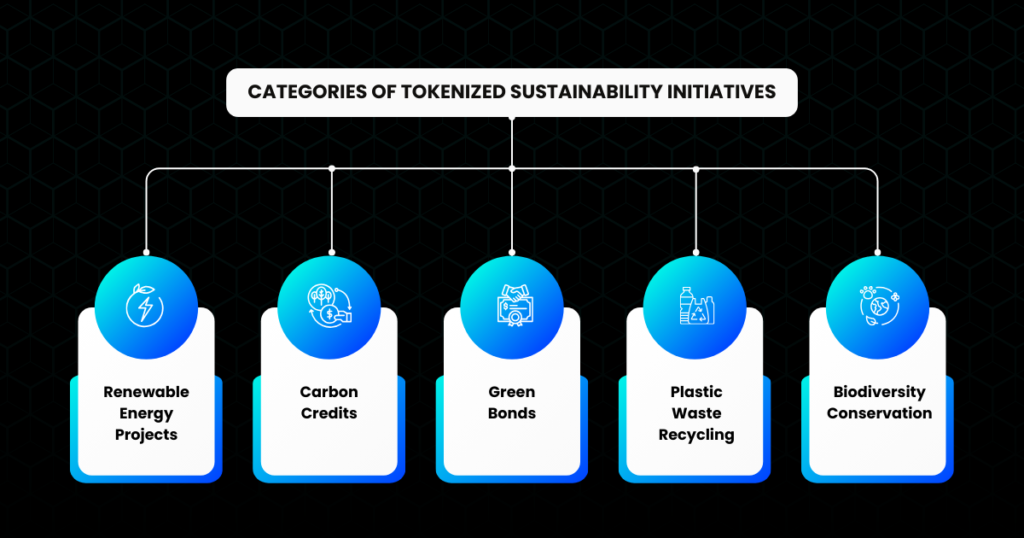
The Benefits of Blockchain for ESG Investment Strategies
Transparent and Immutable Record
Tokenization leverages sustainable blockchain solutions to ensure a secure and transparent record of ownership as well as transactions. Also, it allows immutable records of their ownership which cannot be altered or modified. This promotes trust among the stakeholders and investors ensuring accountability for their environmental and social impacts.
Smart Contracts Automate Reporting
Tokenization further automates the collection and reporting of ESG data following predefined conditions by utilizing smart contracts. This streamlines the process and reduces the management burdens and errors, ensuring real-time insights into sustainability performance.
Decentralization and Real-Time Tracking
Blockchain is the foundational ground for the tokenization process which allows a decentralized environment allowing real-time tracking of assets and activities related to ESG initiatives. This framework permits better visibility into the resource allotment, uses, supply chains, project initiatives, and their impacts, aiding the stakeholders in making informed decisions.
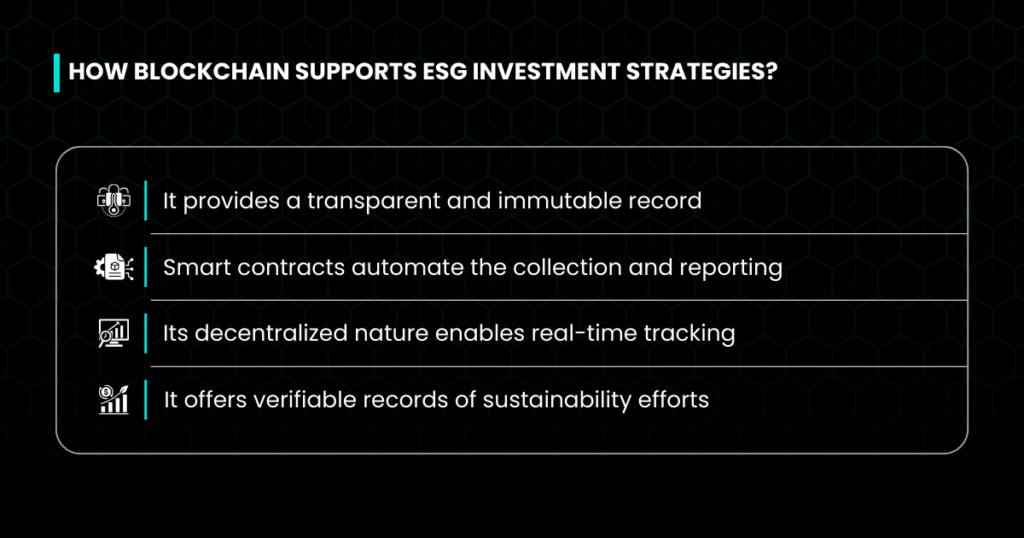
How Tokenized ESG Investments Influence Sustainable Outcomes?
Tokenized ESG investments employ the features of blockchain technology to democratize access to conservative initiatives and sustainable projects. Further, the process is commenced digitally, hence it allows global investors to participate in impactful initiatives.
Impacts on Investors:
- It often provides investors with greater returns by opening new funding sources and enabling access to innovative projects.
- It permits investors to gain more control over their assets and portfolios as well by encouraging direct participation.
- It ensures transparency in these initiatives by providing immutable records of transactions and verifiable data on sustainability efforts for investors.
- It ensures investors with informed decision-making by enabling investors to have accurate and real-time data on ESG performance.
Impact on Environment:
- It facilitates an efficient carbon offset market by allowing investors to trade and invest in tokenized carbon credits.
- It encourages sustainable and ethical investments by providing clear information on the sustainability credentials of projects.
- It democratizes sustainable and conservative efforts and practices, widening the environmental initiatives.
- It increases funds for green and sustainable projects, attracting investment from a diverse pool of investors.
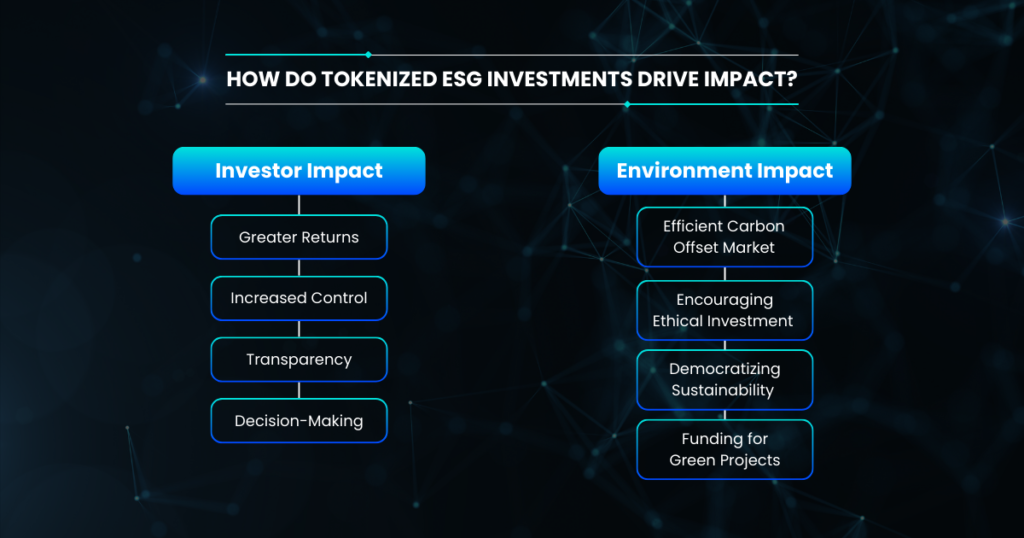
As tokenization in real-world assets is gaining momentum in the market; several platforms allow their trading and investment. One such platform is STOEX.
STOEX is backed by KALP Distributed Ledger Technology (DLT) and strictly adhered to regulatory compliance, ensuring transparency and liquidity. With its structured approach, stringent security, and commitment to compliance, the platform offers an appealing option for diversified and efficient investing. Its regulation, security measures, focus on usability and customer-centric approach make it stand out as an accessible way of trading tokenized real-world assets.
Additionally, STOEX’s vision is to build a ground with reduced entry barriers and encourage a safe ecosystem for every individual interested in investing in the market. It pulls the strings of financial democratization by bridging the gap between investors and high-worth tokenized RWAs.
Conclusion
Tokenization in sustainable finance is rebuilding the domain of ESG investments and opening several opportunities for both investors and the environment. Further, tokenization leverages blockchain technology to provide transparency, liquidity, and global accessibility to these sustainable initiatives. Tokenization encompasses assets like carbon credits, renewable energy, green bonds, and others, aiding in raising funds for sustainable practices. Moreover, there are several positive impacts of ESG initiatives on investors and the environment.
As these concepts are still evolving, various platforms are adding to the layer of opportunities and options within these domains. One such option is STOEX, which allows investors to access the marketplace and trade effortlessly.
FAQs.
What is tokenization in sustainable finance?
Tokenization refers to the process of converting real-world assets, including green and sustainable investments, into digital tokens on a blockchain.
How does tokenization benefit ESG investments?
Tokenization increases liquidity, transparency, and global access to ESG investments, making it easier for small investors to participate.
What are tokenized green bonds?
Tokenized green bonds are blockchain-based digital representations of green bonds, which fund eco-friendly projects.
How does blockchain ensure transparency in ESG investments?
Blockchain technology provides an immutable record of every transaction and project update, ensuring transparency, traceability, and security.
Can tokenization help in scaling renewable energy investments?
Yes, tokenization can scale renewable energy investments by making them more accessible to a global network of investors.
